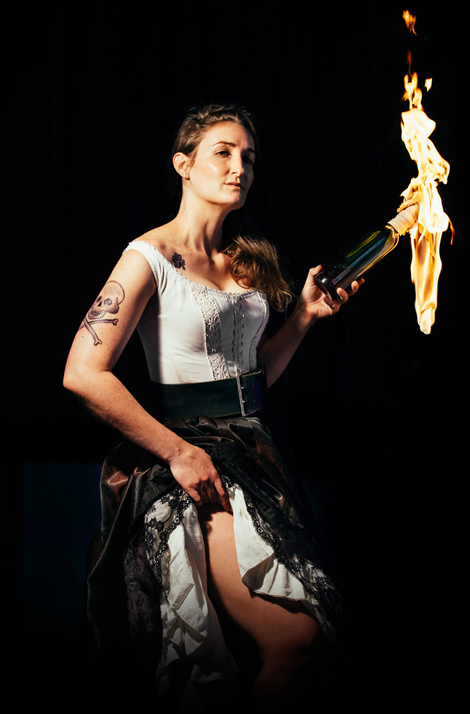a damn hard act to follow

Double Feature | Reviews
Lucky +
Lord Willing and the Creek Don’t Rise
May 19, 2015
MKA’s Double Feature is a blinding example of the talent found on Melbourne’s local art scene. The two works, Lucky and Lord Willing & the Creek Don’t Rise both speak of two unique subjects that are very much of the ‘now’. Both are as delicate as they are bold, as reverent as wanting of conversation to strike post show. The immediate response since opening last Friday has been polarising, worthy of the buzz that has ensued.
Lucky is a razor sharp, dark, brooding piece of theatre, that tells of a story so rich with stimulus that it needs not afford any mistruth. Here, what lies at the heart is a story of three escapees running from establishment in the early days of white settlement in Australia.
As the lights fade in The Lawler Studio, the unmistakable opening to Icehouse’s Great Southern Land begins to play, it’s from the comforts afforded by something so recognizable, that audiences are thrown back into the gritty, violent realities of our countries modern inception.
Moving from the opening scenes, our then narrator becomes an individual on the run, with two convicts in toe. Later in the performance we are introduced to a high school principal on the verge of a breakdown, and also a piano mover that is as shifty as his convict ancestry. Each of these characters are perhaps not so much as related, as having ‘come’ from the same country.
The performance takes place through scenes that are in both the past and present contexts, the success of these transition between past and present can be as much attributed to the detailed and well researched writings of Tobias Manderson-Galvin as it’s to the refined direction of Jon Kachoyan.
A performance fortunate enough to have such a dynamic pairing at the helm is, as Lucky illustrates, bound to succeed, and succeed it does. They have taken risks, they’ve been bold, and they here present something nothing short of visionary. Though visionary not in the manner of some shinning luminary, but one, which is realistic, befitting of all those dark shades and uncomfortable truths such, affords.
Lucky is performed by Mathew Cooper, Johnny Carr and Devon Lang Wilton – each member of this trio give it their all. The dramatic shift between past and present moments, their commitment to character and their accents, where all amazing techniques employed to full effect and had you on a knifes edge from start to finish. The monologues each of these characters deliver in the modern context are brilliant, having been directed in a way that further builds upon Manderson-Galvin’s idea that they should not be so much as smooth transition, but instead ‘fracture outwards’.
What Lucky communicates is a stories of white Australia, the unrest found at the heart of our current social and political landscape all while tracing these back to the inspection there of. It was the way these separate stories entwined then slowly unfurled revealing the whole picture, which afforded much of Lucky’s dark brooding energy.
There is something oddly recognizable about all the characters in Lucky, this paired with the deliverance of each performer. How it moved between time, place and context, in turn creating a haunted and beautiful piece of theatre that the memory of, will stay with audience long after they leave The Lawler Studio.
If Lucky is the contemporary then Lord Willing & the Creek Don’t Rise is most certainly the classic, as a performance it adopts from far more traditional methods such as strong emotion, detailed explorations in relationships, and in extension, the breakdown there of. All time, set against a desolate backdrop of a city in ruin. Its heart breaking stuff, though even in such premise, this performance still manages to find humour whilst still affording moments of genuine warmth.
You know what’s going to happen here, a guy’s going to eat his girlfriend, and even with this firmly in your mind from the outset, it still is a riveting story line. As piece of theatre it commences as something tightly coiled, and with each ensuing scene it slowly begins to unravel – as do the characters.
It’s easy to see what references have been lifted from the devastation felt by New Orleans circa 2008, hometown of writer Morgan Rose, though it’s interesting to note the strong connection to Brisbane shared amongst both ensemble and creative team. The cross overs between Australia and New Orleans are carefully and considerately woven, found mostly in the subtle references, such as the sound of jazz sometimes floating to the surface of the soundscape designed by S.S Sebastian. Whereas, more local reference came from colloquiums in the script, matched with the ballsy-ocker delivery of Earl played by Kevin Kiernan-Molloy.
The performance that was most affecting was that of Jan Friedl who played Miss Claire; the gittery old woman who lives next door, who believes the answer to all world problems can be found in a bottle of vodka. Metaphorically it was the degenerate state in which we find her, which provided double entendre, in essence, she is this destroyed city as much as the destroyed city is her.
There are some great moments which employ device more often found in physical theatre performance, but it’s these extra nuances that add further layer to the work, it was sheer joy watching Friedl first enter the space brandishing her walking stick in the air, then hitting the ground with each off step.
There has been some debate recently about nudity, and its place/value within performance, here in Lord Willing & the Creek Don’t Rise, there is one particularly heated scene where performer Morgan Maguire who play’s Suzy, removes her clothing, though fitting, its necessity is questionable – what was wanting to be communicated could have achieved without the need for such device?
At times this performance perhaps leaned towards being over-acted, with some of the tension built up over earlier scenes becoming lost in the closing one, perhaps shaving 15 minutes off the run time would have easily provided remedy for such issues. Though, being such a solid piece of theatre this is only a very minor criticism.
This performance is in one word; riveting, with perhaps the most telling example coming from the bodily reaction felt in response the final moments of this performance, as the continual flashes of light used to segment and keep rhythm here; finally fades.

